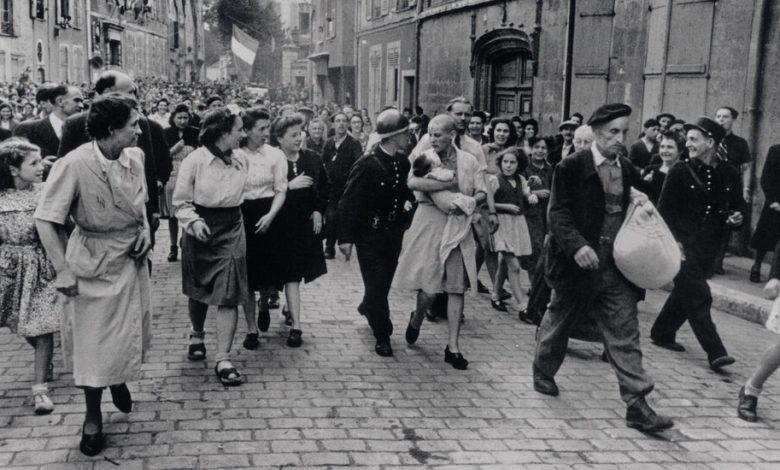Who Was the Real ‘Shaved Woman of Chartres’?

In August 1944, in a city near Paris, Robert Capa took a photograph of a woman cradling a baby in the middle of a jeering crowd, her head shaved and her forehead marked with a swastika.
The woman, Simone Touseau, would become infamous — first as a symbol of the brutality of post-occupation France and later, through painstaking scholarship, as an example of the Nazi sympathies among some of the French during World War II.
A novel released in France this summer has reinvented her once again, this time as a woman scorned. It’s a reinvention that is a disservice to the complicated truth about Ms. Touseau and her and other Frenchwomen’s deliberate collaboration with the Nazis. Women collaborated out of cowardice, self-interest and a whole range of ideological fervor. A reality we should contemplate frankly if we’re to have a proper accounting of the history of the war in France.
The photograph, “The Shaved Woman of Chartres,” with the young Ms. Touseau at its center, was understood for a long time as a document of the brutal purges that took place during the liberation of France at the end of World War II. Extrajudicial punishments were carried out all over the country, including shaving the heads of women suspected of sleeping with the enemy.
The truth was more complex. Historians were slow to take an interest in the wartime collaboration and resistance of women, but in the early 2000s, a groundbreaking work by Fabrice Virgili described how many women who were shaved in the purges were being punished not for their intimate relationships with Germans but for denunciations or working for the Germans.
Eventually we got a clearer picture of Ms. Touseau, too. In 2011 two historians, Gérard Leray and Philippe Frétigné, established that she was a Nazi sympathizer before the war started. She scribbled swastikas in the pages of notebooks she kept as early as the mid-1930s, admired National Socialism and claimed that France “needs someone like Hitler.” Fluent in German, she worked as a translator for the occupying forces and became a member of the nationalist Parti Populaire Français. She was accused of denouncing four neighbors who were deported to the Mauthausen concentration camp, two of whom never returned. The crime, which would have been punishable by death, was not proved, but Mr. Leray told me that he is adamant that she played at least some part in it.
When the Allied forces were in the process of freeing France, Ms. Touseau wrote to the German father of her child that if she was killed, he should raise their daughter “in hatred of the British.”
The infamous martyr of the purges was a committed collaborator. Mr. Capa’s image of the shorn woman was one of victimization but also accountability.
This was an important moment in our understanding of history. Memory of World War II in France is still mutable and fragile and underpins debates that we as a country are still having. (As recently as 2019, Eric Zemmour, a far-right pundit who ran for president, was still trying to spread the long-disproved idea that Maréchal Pétain saved French Jews rather than volunteered to send more to the death camps.) Understanding women’s role correctly is essential to an honest inspection of that history.
This August a new, fictionalized portrait of Ms. Touseau was published in France, in the shape of a novel, “Vous Ne Connaissez Rien de Moi” (“You Know Nothing About Me”), by Julie Héraclès, which renders Ms. Touseau, renamed Grivise, as a woman scorned.
In the novel Simone falls in love with Pierre, who is young and handsome and from a bourgeois family. He sexuallyassaults Simone, and when she falls pregnant, he abandons her to join the Resistance, leaving her to have an illegal abortion on her own.
Simone’s desire for revenge drives her to start working as a translator for the Nazis. She begins a relationship with a German officer, Otto, then falls in love with him. After he is injured on the Eastern Front, she joins the Parti Populaire Français to get a transfer to Germany to be with him, with little consideration for the political implications.
The Simone of the novel has a Jewish friend, lies to the Gestapo to help a member of the Resistance, is “revulsed” by the practice of reporting neighbors and gives food to a little Jewish girl — all “highly implausible facts,” Mr. Leray told me.
It makes for gripping reading, and the novel was on numerous award lists and won the Stanislas Prize for best first novel. Critics praised it as impressive and audacious, and readers shared their enthusiasm for it — “a beautiful love story,” a “real immersion in Simone’s life,” a story “that shows us that people are never angels or demons but a tangle of good and bad,” several wrote in online reviews.
But the book has also been the subject of criticism on the question of what fiction can allow itself when it comes to this part of history.
Ms. Héraclès told me in a phone interview that she was surprised by the debate. Her agenda was not to redeem Ms. Touseau, she said, but “to explore the human condition” by trying to imagine “how a young woman can commit criminal acts.”
The novel has an epigraph: “I’ve never seen a saint or a bastard. Nothing is all black and white; it’s the gray that wins. Men and their souls, it’s all the same.” But relegating Ms. Touseau to the role of a sentimental being buffeted by history does not enrich our understanding of her. It strips her of agency and impoverishes our sense of history at the same time.
The shaved woman of Chartres was a driven, ideological woman whom painstaking historical scholarship had liberated from our simplistic understanding of her. At any given time, people are a tangle of good and bad, and it is the prerogative of fiction to mold bare facts for artistic ends. But now fiction has put her back in the limited, familiar role of sacrificial mother that she inhabited in Capa’s photo and the world’s imagination.
Perhaps we prefer her there, rather than contemplating her and others’ complicity in evil.
Valentine Faure is a contributing writer to Le Monde.
The Times is committed to publishing a diversity of letters to the editor. We’d like to hear what you think about this or any of our articles. Here are some tips. And here’s our email: [email protected].
Follow The New York Times Opinion section on Facebook, Twitter (@NYTopinion) and Instagram.



